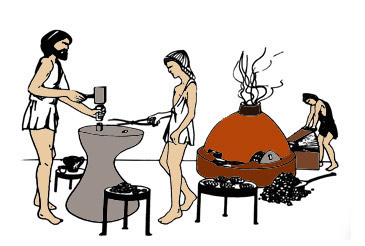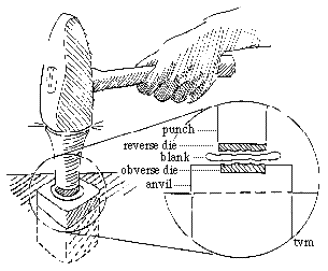
Coins making in Ancient Greece


Ancients Greeks used to make their coins by placing a metal mass between two stamps (moulds) carved with the scenes that would appear in each side of the coin and then they were hitting them with a hammer until the scenes were stamped on the coin. The mass was heated in order to be soft enough for the carving purposes.
The procedure started by melting the metal and then pouring it into round bars. It was then cut in disk shaped pieces which had the same diameter and the same weigh, factors which defined the value of each coin. The discs were turned to coins once having been hit by the workers in order to be stamped. Each coin was created separately thus special care was needed on the part of the worker. The moulds on which the scenes had been carved were made of bronze, iron or brass and as they faded after having transferred their carving to many coins, they had to be replaced especially in the case a large coins number would be needed. The moulds engraving must have been a pricey procedure so sometimes the old ones were copied in order to be used for next generation coins.
|
The mints were small buildings and the workers used the following tools; a furnace, a scale, a scorp, a punch and a pair of tongs that were used for placing the disc on the anvil where the front side mould had been placed. On other side of the coin a pinch on which the scene had been engraved, was placed. The first side was hit by the worker with a hammer so the coin was pressed from both sides thus the carving was achieved. In the first years, there were no discs but round metal masses until the round bars were invented. Metals abundance was necessary for the production of coins. A small city could just trade its products in order to buy the precious metals. On the other side, the large cities like Athens needed much more metal quantities which they used to take from the mines. For example, Athens pumped it from Lavrio mine, Aegina from Sifnos mine, King Philip II from Damasteio and Paeonia while Alexander the Great took advantage of the mines located in the areas he had conquered. The Ptolemies were provided with metals from the mines of Nouvia and from Cyprus. |






